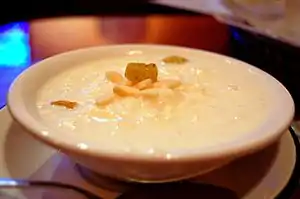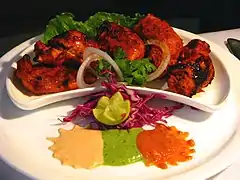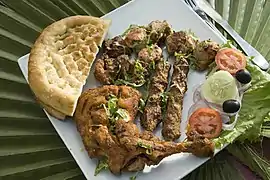Kheer
Kheer, payasa, payasam or phirni is a type of pudding from the Indian subcontinent, made by boiling milk, sugar, and rice, although rice may be substituted with one of the following: bulgar wheat, millet, tapioca, vermicelli, or sweet corn. It is typically flavored with desiccated coconut, cardamom, raisins, saffron, cashews, pistachios, almonds, or other dry fruits and nuts. It is typically served during a meal or as a dessert.
 A bowl of kheer | |
| Alternative names | Payasam, Payasa and Ksheeram |
|---|---|
| Place of origin | India |
| Region or state | India, Pakistan, Bangladesh, Sri Lanka, Bhutan, Nepal |
| Main ingredients | Rice, milk, sugar, cardamom, jaggery, saffron, pistachios or almonds |
| Variations | Barley kheer, Kaddu ki kheer, paal (milk), payasam, payesh |
| 249 kcal kcal | |
Etymology
The word kheer is derived from the Sanskrit word for milk, ksheer (क्षीर). Ksheer is also the archaic name for sweet rice pudding.
Origin
Kheer was a part of the ancient Indian diet and is mentioned in the Ayurveda.[1]
According to the food historian K. T. Achaya, kheer or payas, as it is known in southern India, was a popular dish in ancient India. First mentioned in ancient Indian literature, it was a mixture of rice, milk and sugar, a formula that has endured for over two thousand years. Payas was also a staple Hindu temple food, in particular, and it is served as Prasāda to devotees.[2]



